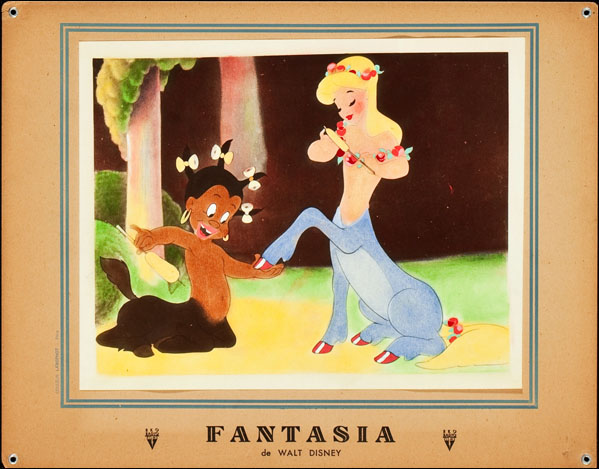
SUSPENDED ANIMATION #260
In Disney’s animated feature Fantasia (1940), The Pastoral Symphony takes place in the serene shadow of Mount Olympus and presents a story accompanied to the music of Beethoven’s “Sixth Symphony”.
In the Disney version, famous Grecian creatures, like pegasi (the official plural of pegasus), satyrs, centaurs and cupids, leapt from the dusty pages of mythology books to flirt with the opposite sex, indulge in freshly made wine and to dance and play in the “candy box colored” Elysian Fields until prankish Zeus puts an end to the party.
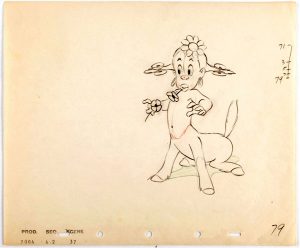 Male centaurs, creatures who were half-man and half-horse, had been illustrated for centuries in stories where they usually appeared as muscular stallions with chiseled Mediterranean faces and torsos.
Male centaurs, creatures who were half-man and half-horse, had been illustrated for centuries in stories where they usually appeared as muscular stallions with chiseled Mediterranean faces and torsos.
Disney artists created a never-before-portrayed, delicate female version that they dubbed “centaurettes”, the very first time that term was ever used. Supervising animator Fred Moore was assigned the task of creating concept sketches that brought femininity to characters who might have appeared grotesque in less skillful hands since they were, after all, half horse.
Sunflower was called Sunflower because in the scene where she is braiding flowers into a centaurette’s tail, Sunflower wears a huge sunflower on the side of her head. It is apparent that Sunflower is a subservient character, like the cupids, whose primary purpose in life is to care for the centaurettes. She is significantly smaller and younger than all the other centaurettes.
Sunflower is a stereotypical caricature of an African American female child of the time, as evidenced by her distinctive hairstyle in which parts of her hair are separated by hair-bands of cloth into multiple stubby, spike-like bunches equivalent in size often used as a stereotypical visual in live action and animated films to define an African American child.
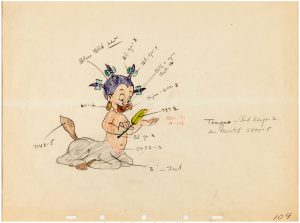 In 1969, with the rise of the Civil Rights movement in the United States, the segments with Sunflower were cut completely, causing short blips in the accompanying soundtrack that was also eliminated along with those cuts.
In 1969, with the rise of the Civil Rights movement in the United States, the segments with Sunflower were cut completely, causing short blips in the accompanying soundtrack that was also eliminated along with those cuts.
For its 60th Anniversary DVD release in 2000, Disney’s manager of film restoration, Scott MacQueen, supervised a restoration of the original 125-minute roadshow version of Fantasia, so that Disney could officially announce this was the original and “uncut” version of the film.
This feat of trickery was accomplished by clever panning and digitally zooming in on certain frames to avoid showing Sunflower. For instance, the camera focused on the preening centaurette and not Sunflower at her feet polishing the hooves.
Four shots were reframed and others that were beyond redemption were changed by repeating some frames.
First, at the beginning, as the centaurettes languidly primp with the help of the flying cupids, one has her hair combed while another has her tail braided. The very next shot introduces Sunflower on the left-hand side of the screen holding the hoof of a pretty white-haired beauty.
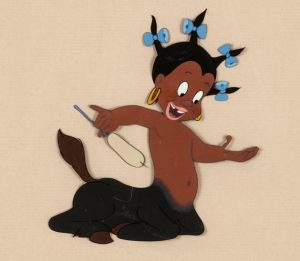 Sunflower blows on the hoof and polishes it with a white cattail plant (often found growing near bodies of water) in an action reminiscent of the African American shoeshine boys of the time. At the same time, the aloof centaurette buffs her fingernails with a similar cattail. The animators for this scene were Bill Justice and Milt Neil.
Sunflower blows on the hoof and polishes it with a white cattail plant (often found growing near bodies of water) in an action reminiscent of the African American shoeshine boys of the time. At the same time, the aloof centaurette buffs her fingernails with a similar cattail. The animators for this scene were Bill Justice and Milt Neil.
Second, after the centaurettes, with the help of the cupids, find appropriate head gear, the scene with the centaurette using doves in her hair then cuts to Sunflower diligently putting a dozen or more pinkish-purple flowers into the yellow tail of a centaurette.
Sunflower is visibly disconcerted when the centaurette can not hold still and swishes her finely combed tail as she rushes to catch a glimpse of the approaching centaurs. All the carefully placed flowers fly into the air as Sunflower places her hands on her hips and looks disapprovingly as they float to the ground.
Officially, this is Scene No. 37 and the description of the action on the draft is “Sunflower (Black Centaurette) pins flowers in the tail of ‘Judy’—Judy swishes her tail scattering the flowers. Sunflower annoyed.” The animators for this sequence were Milt Neil and Joshua Meador.

The centaurettes had names? To help the animators distinguish between the centaurettes, the official draft of the scenes gives each of those characters a name. The centaurettes gazing out through the vines are identified (in order) as Sandra, Hilda, Melinda, Judy and Cabina. (However, even though Melinda is listed, she does not seem to appear in the scene as finally animated.)
Melinda is the centaurette with the pale blue body and yellow hair in pigtails—the only centaurette who doesn’t “hook up” until the cupids help her do so with the buff centaur Brudus. (He is called Brudus because he “broods” that he doesn’t have a girlfriend as does all the rest of his fellow centaurs.)
 Undeterred, Sunflower then follows the centaurette Judy to the grove where the other centaurettes are peering through the vines and, once again, on the left hand size of the scene, attempts to add decorative flowers to Judy’s tail.
Undeterred, Sunflower then follows the centaurette Judy to the grove where the other centaurettes are peering through the vines and, once again, on the left hand size of the scene, attempts to add decorative flowers to Judy’s tail.
Officially this is still considered part of Scene No. 37. Animation by Bill Justice and Paul B. Kossoff.
Third, after the centaurettes parade down the stair-like grassy levels to display their attributes for the eager young centaurs, the scene cuts to a pink-haired centaurette with a garland of flowers around her waist walking back and forth. A little Black centaurette prances proudly along behind her, holding the other end of the garland high in the air as if it were the train of an elaborately long dress.
However, this Black centaurette is not Sunflower. In the official draft it states that “Atika (colored centaurette) holds Hilda’s train.” “Colored” was a term at the time that referred to African Americans.
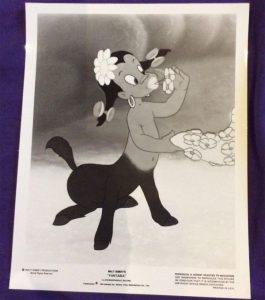 Atika, except for a different hairstyle, looks exactly like little Sunflower, resulting in many viewers to just assume it is the same character. Instead of the offensively labeled “pickaninny hairstyle” of Sunflower, Atika’s hair is in two pigtails. Just like Sunflower, Atika has been removed optically from the scene.
Atika, except for a different hairstyle, looks exactly like little Sunflower, resulting in many viewers to just assume it is the same character. Instead of the offensively labeled “pickaninny hairstyle” of Sunflower, Atika’s hair is in two pigtails. Just like Sunflower, Atika has been removed optically from the scene.
Finally, it is Sunflower who unrolls the red carpet up the steps to the makeshift barrel throne of Bacchus. The playful satyrs and Jacchus, the donkey unicorn, follow behind her and desperately try to guide the unsteady and boisterous Bacchus up to his seat.
Sunflower stands behind the seat to steady it and tries unsuccessfully to help as Bacchus loses his balance and tumbles forward, causing an upset Sunflower to run around in circles with fearful despair and her hands on the sides of her head. Once again, it is Neil and Kossoff doing the animation of the character.
On the currently available Blu-ray version, the red carpet magically rolls itself up to the barrel throne and all evidence of Sunflower has been erased from the scene with Disney cine-magic.
The episode of the weekly Disney television series entitled Magic and Music (first shown March 1958) showed The Pastoral Symphony segment intact, including scenes with Sunflower. A repeat broadcast in 1963 was edited to remove Sunflower, and that is the version that was usually rerun ever since on television.
This editing was done while Walt was still alive and was in charge of approving everything that happened at his studio and so he obviously had no objections. This type of retroactive editing was not unusual.
Although the Disney Company has been aggressive in removing any video of Sunflower from the Internet and various websites, a persistent Disney fan may be able to find several locations where these scenes can be viewed complete and uncensored.


 Jim Korkis is an internationally respected animation historian who in recent years has devoted his attention to the many worlds of Disney. He was a columnist for a variety of animation magazines. With his former writing partner, John Cawley, he authored several animation related books including The Encyclopedia of Cartoon Superstars, How to Create Animation, Cartoon Confidential and Get Animated’s Animation Art Buyer’s Guide. He taught animation classes at the Disney Institute in Florida as well as instructing classes on acting and animation history for Disney Feature Animation: Florida.
Jim Korkis is an internationally respected animation historian who in recent years has devoted his attention to the many worlds of Disney. He was a columnist for a variety of animation magazines. With his former writing partner, John Cawley, he authored several animation related books including The Encyclopedia of Cartoon Superstars, How to Create Animation, Cartoon Confidential and Get Animated’s Animation Art Buyer’s Guide. He taught animation classes at the Disney Institute in Florida as well as instructing classes on acting and animation history for Disney Feature Animation: Florida.




















































“…pegasi (the official plural of pegasus)….”
This sort of thing used to exasperate my father, so if I may be permitted to make the case for the opposition, in loco parentis as it were:
Pegasus is a proper noun, the name of the winged horse who, along with his twin brother Chrysaor, was born fully-grown from the blood of Medusa after Perseus decapitated her. Thus there is no plural form of Pegasus, because there was only one of him. The generic Greek term for a winged horse is “pterippus” (pteros = wing, hippos = horse). Pegasus was a pterippus, and Rainbow Dash and Fluttershy are pterippi, not “pegasi”.
My father held steadfast against the corruption of Classical grammar like King Canute ordering the tides to desist. He never stood a chance against My Little Pony fandom. He was right: “pegasi” is incorrect. Jim is also right: the incorrect form is now official. Sorry, Dad.
The centaurs themselves provide a precedent for a proper noun being applied to a race of mythical beings. Centaurus, the son of Ixion and Hera (technically, a cloud in the shape of Hera that Zeus created to fool Ixion), fathered the centaurs through his predilection for, um, well, equine love. But Pegasus, though an example of a pterippus, was not the progenitor of a race. His mother was a Gorgon, his brother was a demigod, his nephew Geryon was a three-headed giant, and his niece Echidna was half-woman, half-snake. And you thought the Addams Family was altogether ooky.
As for the “centaurettes”, my father would have grumbled at the impropriety of appending a French diminutive suffix to a Greek root. But I think it’s cute.
By the way, did the Disney animators ever come up with names for the two zebra centaurettes who attended Bacchus? I wish that Bacchus had starred in his own series of cartoons. He could have been voiced by Jim Bacchus.
… or Jim Backus.
Paul, your father would be proud of you still championing opposition to the corruption of Classical grammar. While I know the official name is “pegasi” when I talk about the flying horses in the scene, I refer to them as “peagsuses”.
When Bacchus first appears he is accompanied on either side by two stately Nubian zebra centaurettes, one with a large blue feather fan and the other with a blue jug of wine on her shoulder. Their brown torsos, ethnic facial features, and decorative gold rings in their piled high hair define them instantly as different from the rest of the centaurettes.
They only appear for a few seconds during this entrance and disappear for the rest of the film never partaking in the festivities. Unlike Sunflower and Atika, they are obviously adults and despite their subservient functions have a stately dignity and intelligence. From the scene drafts I saw, they did not have individual names because of their brief appearance.
Plural of ίππος is ίπποι, not *”ίππι” (it seems like a Latin declension). So the plural of “pterippus” should be “pterippoi”, not “pterippi” (and the singular form “pterippos”, not “terippus” btw).
Another great Disney post. Much ap´preciated, JIm.
You make an excellent point, Felipe, and your transliteration of the Greek is completely accurate. However, when Classical Greek terms are incorporated into English using Roman letters, certain conventions of Latin orthography are commonly observed; for example, rendering the letter kappa as C rather than K (as in “Corinth” or “cephalon”). In Greek nouns ending in “-os”, the omicron before the final sigma normally becomes a U in the singular form and is omitted in the plural, corresponding to the Latin nominative declension (as you noted). That’s why we write “hippopotamus” and “hippopotami” rather than “hippopotamos” and “hippopotamoi”. Ergo, in English text “pterippus” and “pterippi” are correct. Quod erat demonstrandum!
I think this is my favorite comment thread of the week from anywhere on the internet. Thanks, Paul, Felipe, and Jim!
Interesting and informative post.
Wow…and double wow. Had never seen all of her footage. Astounding! Thank you!!
Be neat to see that superb quality in a complete version of THE PASTORAL. Great piece. Thanks.
My how peaceful and non-racist the world is because Disney censored Sunflower and Atika from “Fantasia”. Not to forget censoring “Song of the South” as well. Or forbidding the uncut version of “Mother Goose Goes Hollywood” to be seen, for good measure. As Uncle Remus said, “You can’t run away from trouble, ’cause there ain’t no place that far”.
Our world was also vastly improved by cutting all the shots from the early 1930s Mickey Mouse shorts on the Mickey Mouse Club, in which Mickey spits! In “When the Cat’s Away”, especially.
Thanks for an engaging post, Jim.
Not to mention the removal of Pecos Bill’s dangling cigarette in MELODY TIME (despite it being mentioned in the song) yet still keeping Jose Carioca’s cigar in the segment “Blame It On the Samba”.
But wasn’t “Mother Goose Goes Hollywood” complete on the “Walt Disney Treasures: More Silly Symphonies” set? The only one that was not shown complete was “The Night Before Christmas” which they solved with a disc replacement service ( I have it).
There seems to be this idea out there that Walt Disney tried to be a terrible influence on our society, and that he created the very expensively produced Fantasia with its elaborate Fantasound system to promote racism or to lower our capacity to enjoy classical music or something equally nefarious. I doubt that any child somehow staying attentive throughout the complete 2 hour film would be adversely affected in any way.
Do we have any studies suggesting that children exposed to early Disney films behave in more socially disruptive behaviors than those who don’t?
A black child would be.
Good comment, Mark.
Wow, I think that’s the first time I saw those shots. I understand why they were deleted, and I can see why some would find them offensive, but I think they’re no worse than quite a bit of what’s in GONE WITH THE WIND. Note you don’t see that film getting censored.
The difference is that children don’t watch GONE WITH THE WIND. While FANTASIA was not made specifically for children, they are a large part of the audience. It is like Disney removing the line “They cut off your ear if they don”t like your face” from ALADDIN, or the scene with the Big Bad Wolf as a stereotypical Jewish peddler in THE THREE LITTLE PIGS. One should be careful about exposing impressionable children to outdated, insulting ethnic stereotypes. ‘You’ve got to be taught to hate and fear . . .”
that’s not a difference, but an excuse. There is plenty of free music and movies that do the reverse now-a-days, but since it’s against a majority, it goes unchallenged
What children’s media “do the reverse now-a-days”? Where do you see a white character equivalent or even remotely comparable to “Sunflower”?
Jim K sez: “While I know the official name is “pegasi”… I refer to them as “peagsuses”.”
Yeah, right! Kinda like “breasteseses.” Right? Right?
Which directly prompts me to ask: what’s with the incomplete breasteseses on the centaurettes?
Ramblings of a sequestered brain…
I assume what you’re wondering is, why don’t the centaurettes have visible nipples? I figured this out a long time ago.
We may surmise that centaurs, like horses, are able to stand on their own four legs moments after birth. A newborn foal weighs about ten percent as much as its dam — about 45 kilograms (100 pounds) for a thoroughbred, or 90 kg (200 lbs.) for a draft horse. Therefore a newborn centaur would be much too heavy for its mother to hold in her arms for any length of time. It follows that the nipples used for lactation are located on the horse portion of the centaurette’s body, and the breasts on her human torso, however interesting in situ, are non-functional. The centaurettes in Fantasia are virgins, and we cannot see their lower nipples because they have not yet foaled.
Parturition would be a complicated process in centaurs, and breech births would have a very high mortality rate. They would also be subject to a variety of spinal ailments, especially lordosis, and the centaurettes in particular would suffer from iron and calcium deficiencies as they age. They should probably go easy on all that red wine at the Bacchanalia — but hey, I remember what it was like to be young….
The centaurettes were in fact originally designed with nipples. But during production they had to cover up. Just another reason to be against censorship. The centaurettes were not allowed to roam about freely.
And yet the harpies in “Night on Bald Mountain” have visible nipples. Go figure.
Actually, female centaurs had turned up in animation before. Winsor McKay did this, which feels like a test run for something bigger:
https://www.youtube.com/watch?v=hoVHhIoyoO4
Oddly enough, the female demons in the NIGHT ON BALD MOUNTAIN sequence are anatomically correct. Clearly, nipples are a sign of evil.
Could someone please identify the centaurettes with their “given” names?
PS. first time actually commenting, I’m huge enthusiast living in Sweden.
Not possible with the information given here. The article only gives names for five centaurettes, yet there are no less than ten centaurettes bathing by the waterfall in the opening scene alone. Some, like the fuchsia-haired centaurette in the birch bark hat or the redhead with the doves, only appear in a single shot. So call them whatever you like, William, and welcome to the party!
If they’re not going to present it without censoring it, then what I wish they would do is recolor the little black girls so that they become very ambiguous as to their original ethnicity. It seems to me that with digital technology this would be relatively simple. Change the hair color to red, or purple, or blonde, or gold, or silver, or something. Change the skin tone, of course, too. One of the centaurettes looks almost blue, do the same to the little girls — or some other color. And of course, don’t make the color of the lips different, or make them only slightly different, so that they’re not emphasized as much. I think this would satisfy most people.
I for one never found Sunflower and the other black centaur as an offensive stereotype. I am hoping for those original scenes to be remastered.
How shocking that BENJAMIN VANNESTE doesn’t find the racial stereotype of a black pickaninny slave girl offensive!
When I wrote an earlier Cartoon Research story about the Fantasia soundtrack album some time ago, I was not aware that the three-record Fantasia set was edited on side four some time in the seventies so the Pastoral Symphony reflected the slightly shortened version.
This is true because I purchased the first set in 1972–practically wore it out–and bought the second set at least a decade later. I played each of them recently and was surprised to hear the difference. When Irwin Kostal conducted the digital restoration in 1982, of course the Pastoral was performed to reflect the change.
Oddly enough, while the clumsy edits and frame enlargements that plagued the 1968-2000 editions of Fantasia, the newest version as seen on streaming platforms and Blu-ray uses extensive re-animation and repainting for a far more seamless and non-distracting presentation. While it would be nice for it to be available as it was made (in addition to at least what survives of Deems Taylor’s voice), kudos to Disney for at least doing it as Walt would have preferred.
i watched it just now for the first time (on disney plus). it gave a warning about racist depictions at the start, so i was expecting it to show sunflower (which i’d read about), and then got to the end of the section and was like.. huh, was i not paying attention hard enough. for some reason they took it all out but still gave the trigger warning. i’m impresssed how it was all done seamlessly though. i never noticed anything being out of place.
Great research and preservation! Not only does this solve the mystery of older norms, which are now so-called racism (yet those depictions were actually true in that time, and even still in ours), but it also exposes a greater evil of propaganda a-la “Nineteen Eighty Four” — the story wherein a tyrannical government alters the truth of history to cement their fiction of the present (‘Who controls the past, controls the future: Who controls the present, controls the past”).
The same is true in the “presentation” of Fantasia itself, as the Disney principle & corporation change the presentation of the film under the guise of “up-dating” it for new audiences. One need only to view the various presentations released over the years to see coloring and brightness and contrast are being changed as well. “Can that be so bad,” one might ask? Well, let premiere filmmaker George Lucas of “Star Wars” fame answer that question, before himself becoming the premiere graffiti-sprayer of every release of his films since then:
What George Lucas Thinks Of Other People Altering Old Films — https://www.cinemablend.com/new/What-George-Lucas-Thinks-Other-People-Altering-Films-91907.html
“People who alter or destroy works of art and our cultural heritage for profit or as an exercise of power are barbarians, and if the laws of the United States continue to condone this behavior, history will surely classify us as a barbaric society.” … “American works of art belong to the American public; they are part of our cultural history.”
Et tu, Brute? … Lucas? … Disney? 😉
I realize this comment is two years old, but there has been a resurgence of interest in this lately. So I would just like to say that you are an absolute moron. I’m not even going to bother with arguments, because there’s nothing to argue when your opponent is as dimwitted as you are. What a stunning example of idiocy.
i’m not sure george lucas is the best person to be citing here. as 1) he literally would not stop altering his films. he’d still be doing it now if he hadn’t passed lucasfilms on to kennedy, and sold everything to disney. 2) he himself was pretty clumsy with using negative ethnic stereotypes in his movies
Which one of the centaurettes who were looking through the vines is “Sandra”?
It´s kind of cool to know that one of them has the same name as me.
It’s really disgusting and humiliating how people of color have been dictated, illustrated in an ugly and insultive way.
I’m glad this was certainly edited out.
Enough horses and photos of black women, whose complexion truly embodied the color of horses and even a photo of an African female model where her and the mare’s s deep dark brown pigment matched the horses precisely.
Talk about obvious beauty.
Maybe thats why the centaurette are these ridiculous candy colors – Dude I really wonder.
As an artist – this is disgusting. Also for the record centaurs are male not female.
i agree strongly with the first part.
but i loved the candy colours and was surprised to see this kind of thing was as far back as the 40s. i’d thought it was something that started in the 80s (care bears, my little pony etc).
and these are centaurettes, not centaurs. they are named so in the introduction. this is fantasia, not realismasia, so it’s not obliged to be true to life, or original mythology/literature. i’m fairly sure that the original sorceror’s apprentice (written by goethe) wasn’t a mouse.
Honestly, with all sincerity, fuck America.
Great post, Jim, I just came across it.
You are so prolific it is almost impossible to keep up.
You are a “one man wrecking crew” in all things Disney–wide ranging and always super well informed.
Thanks!